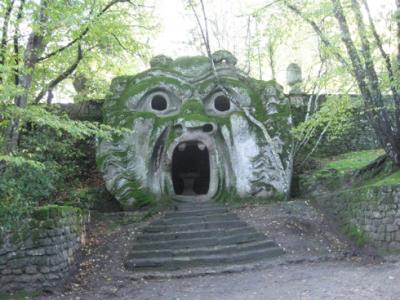Eerie, Elegant and Entertaining: "Signatures in Stone"

PISA- Set in 1928 in the region known as Tuscia, this mystery novel by American author Linda Lappin will intrigue you with the vista it opens on part of Italy that deserves to be better known. Lappin’s credentials are impeccable: she has long lived in Lazio and her insider knowledge of Italy is apparent throughout the novel.
Signatures in Stone unites the gothically remote setting of Manderley in Daphne du Maurier’s Rebecca with the psychological claustrophobia of Agatha Christie’s Evil Under the Sun. A small group of disparate characters converge on the ramshackle villa of Bomarzo, famous for its Monster Park. The sophisticated heroine, Daphne DuBlanc, is an English lady of genteel birth whose family has fallen on hard times. One of the novel’s more attractive characteristics is the tongue-in-cheek aplomb with which she handles the vicissitudes of her stay in the ancient villa.
… the villa itself, of yellow stucco with bluish-gray shutters, looked a bit run down. I noticed a couple of broken window panes on the third floor and a place or two where the cornice had crumbled away. My first thought was that I ardently desired a hot cup of tea, and I feared this place might not be able to produce one. My next thought was that I needed a smoke, and I don’t mean tobacco.
The narrative frame-within-a-frame is very enjoyable, with its hall-of-mirrors effect of mystery novel written about a writer of mysteries. Bit by bit we are introduced by all the characters: Nigel, Daphne’s lifelong friend, publisher and compatriot; Clive, a young Texan with pretensions to artistic grandeur; Professor Finestone, who has leased the villa of Bomarzo in order to complete the scholarly study he is carrying out on the famous Monster Park; Manu, the gruff and boorish caretaker; Amelia, his surly daughter and reluctant housekeeper; and the last arrival, Danilo, a charming adventurer from Rome. Professor Finestone describes Bomarzo’s Monster Park:
“You may think of this place,” he continued, “as a sort of Divine Comedy in reverse, a plunge from paradise to hell […] a dream diary recorded in sculptural form of figures plucked from a lifetime of nightmares.”
In these confined surroundings, guests and servants are forced to endure each other’s company and shortcomings. Soon events take a sinister turn. There is an attempt on Daphne’s life, but she realises she has no real ally to turn to, nobody who will take her anxiety seriously. All the classic Gothic elements of aristocratic decay, death and madness make themselves felt. Things are not as they seem, and the characters succumb to the contamination of the villa’s atmosphere:
A scent lingered when she passed, like sweet peonies rotting in a vase. Something mysterious and impalpable seemed to signal her passage through the rooms, a stirring in the chill air, soft footsteps approaching then retreating, a candle gleam reflected in a brass doorknob or across a sequence of darkened window panes…
And so the stage is set for a climactic series of events, leading to the novel’s dramatic dénouement.
The only quibble regards the era. Given that Signatures in Stone is set during Fascism, it might have been nice to have a few more details of life under Mussolini. But then again, the realities of a grotesque dictatorship might have taken away from Bomarzo and its uncanny Monster Park, immersed in such splendid isolation. A thoroughly enjoyable read. I look forward to more sleuthing from the resourceful Daphne DuBlanc.
Signatures in Stone: A Bomarzo Mystery. Caravel: Pleasure Boat Studio. 2013. 285 pp. ISBN 9781929355907. $18
Elizabeth MacDonald is an Irish author ( House of Cork ) and translator who teaches translation at the University of Pisa.


